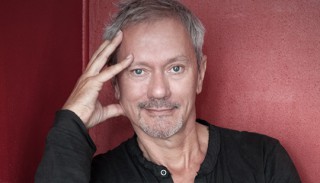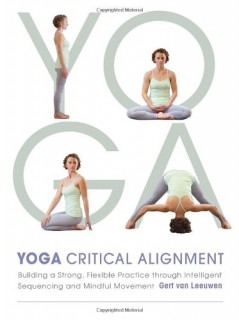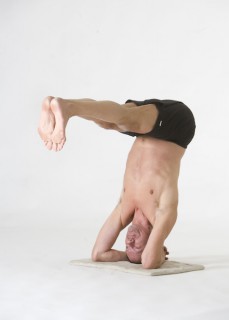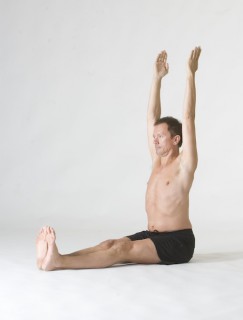Tell us about the features of your method. The term "alignment in asanas" is often associated with yoga of BKS Iyengar. What do you have in common, what is different?
First of all, I don't like to compare my style with other styles because I do not like comparisons. But I can tell you something about the use of the props which I have developed through the years. It was a necessity. It links to the other part of the question which you have asked. Why did I decide to change Iyengar style of teaching? It was not a matter of decision; it just evolved through the years.
My teachers came from that tradition. When they left Amsterdam after some periods of six, seven, eight, nine months everyone was looking at me because I was a teacher those days and I had a small studio. So, I took over. Joining the first class I made the major decision in my life and in my career. I did not want to repeat all their teachings, I did not want to repeat their words, and that’s what I said to my students. I told them: you have your routine in the practice we’ve learned during the past nine months, I will take over, but I will just start to look at you and see what happens.
I did not want to repeat things mechanically. I think it was the best decision I’ve ever made, because when I started to look, the phrases which came out of my mouth were natural, connected to the situation the people were in. Of course, I worked with people who had routine of 20 minute headstand, 20 minutes shoulder stand every day, so it really affected not only the structure of the musculature but also affected the structure of the bones. What I found out is that muscles can be released, movement can be directed by will and by willpower, but when you want to release the skeleton of its structure, to bring the balance into the frame of the skeleton, you cannot use willpower or ambition. The skeleton cannot be moved by that, it can only be moved through pressure using gravity. Those words became far more important to me than words like: “you have to do this”, “you have to do that”.
So, the emphasis of my teaching became in bringing back the balance to the skeleton so that the musculature is about to follow movements of the bones. And then I needed to search for other words like exhalations, pressure, getting willpower out of movement, using gravity, all those kind of things became very interesting.
I found out that people were not able to move into certain parts of their skeleton anymore to release those tensions. I mean you can release your tension through massage on a musculature level, but to make it structural – no, people were not able to do it themselves. That’s how I started to invent those external tools, and that‘s why help from outside made it possible to change the bony structure from inside.
I started to develop the rolls for the lower back, the rolls for the middle back, the straps for the area between the shoulder blades, the atlas, all spinal movements connected to the bones, the headstander to improve balance in areas where we cannot voluntary influence by our own will anymore. That’s how the whole tradition where I came from started to change. It happened very gradually because my interest was on a different focus.
Mostly yoga is executed from concern of the execution of movement, and, unfortunately, in that approach many students still make use of their preference tensions instead of breaking them. Many movements arise due to musculature efforts instead of a deep change of the bony structure underneath.
Difference between Critical Alignment Yoga (CAY) and Critical Alignment Therapy (CAT) is just practical. People who have problems with their bodies e.g. back aches, or shoulder aches, or problems with their arms, or their neck, come and you cannot teach them in general terms. They need a specific attention. So, we distinguish two types of classes between lower back related issues and upper back related issues. For instance, when people have inflammation in their wrists, or their arms, or their shoulder area, you cannot do a dog pose with them, you should avoid movements where they use their arms in strained way, but you can work with the spine in order to release the spine.
And that will become an important part of my practice and experience, that I always start to work from what I call “the source of all our tensions” and that’s the area just below the shoulder blades. People start to harden in that area and people start to bend over from that spot, and in some years they are not able to adjust that posture voluntarily. So, through that, the whole issue from compensatory movements of sports, or whatever they do, or office work, start to affect the shoulders, the arms, the wrists. So it works from there to outside and then the legs, for instance, or the herniated disk cannot function properly anymore, it is useless to work from that prospective. We need to restore the area in the spine and then work through to outside.
So, normal yoga classes although they have strong therapeutic approach in them, are meant for healthy people who can use their arms and legs in a proper way, who have certain understanding of proper coordination.
People who have therapeutic issues should not feel stress, or feel strained, or be frustrated by the fact that they cannot do all general poses in a general yoga class, but they need a special care, special attention in therapeutic classes. We immediately go to that area of the spine. We can start teaching them how to relax those areas, and other affected areas that are at the outside. We are able to release the spine and due to that the circulation and strength gradually come into the arms and the legs, people start to feel more secure. This is what we offer them in special classes between the therapeutic classes and normal regular classes, and then they can gradually shift to normal yoga. That’s the approach.
Concerning the approach what is the main focus of it? In Indian tradition they try to reach Samadhi. And what is your main focus in yoga?
That’s actually totally different question. Original yoga texts are pretty popular in the West, maybe among the teachers rather than among the students, but to follow the eight paths of Yoga I think it is of no value in our society any more. I am not looking for Samadhi and I do not even know what it is, and I think nobody knows what it is.
We talk about it giving our own interpretation. I am not teaching yoga outside the society. Some people do their meditation practice in isolation from the society. They sit for many hours during a day in some retreats for seven or ten days, to me it feels like an escape. It is clearing the mind up to a certain extent, but if you cannot clear your mind in relation to problems and difficulties that you have to face in society, then all these anxieties, fears, sorrows, depressions, they will not just melt away in a traditional meditation practice. We need to understand the problems that we face in a society, they are the cause of obvious effects, and once we understand their roots, the mind will become quiet by itself.
For me it is a way more important to prepare people through yoga because I do think yogic meditation has a strong function in releasing our structural tensions and structural chronic diseases connected to that. It is important to release ourselves from that, but not through eight steps in a traditional way.
It comes from understanding movement, how to change movement like I said before, at the level of the skeleton, and through understanding the depth of your tensions the whole issue of relaxation will start to reveal itself. Also in psychological sense when we understand the roots of our fears and roots of our depressions, the roots of our feelings and emotions then through understanding that, the body will, or the mind in a psychological way, become balanced.
When you understand your fears, when you understand your chronic strain through a proper movement, through a proper knowledge, understand the roots of it, then the whole issue, the whole negativity will disappear. To my mind it is useless to separate yoga and meditation from society. It should blend into it. And, of course, it’s extremely complex. It is not just sitting for one hour and who knows what will happen.
Our mind is constructed to that. When you do your best, when you sit for hours and hours, you will be rewarded afterwards. But nobody knows what that reward will be, and nobody knows if there is any reward. I mean we have learned to be persistent in what we do; we want to be competitive in our lives, to become successful. But I do not know if I ever will be successful. It is stated in our minds, it is grounded in our society that you have to work, work, work, work even if it gives so much inconvenience, and the reward will come later.
But I do not know if there is any reward, I do not know if I will become successful, I do not know if I will ever get close to it. Nobody knows. Of course companies want to have healthy workers, so it’s for the interest of the company that you gain that kind of attitude, religion also wants to have followers, and they give their promises to get the followers in.
I don’t think it is a fair play. We have to deal with that. It is another field of willpower, ambitions, competition and so on. We have to learn how to deeply release all those tensions brought by our actions which became traditional in our society, to release ourselves from that ambition, willpower, from all these drives, and see that there is another field in which we can gain another type of freedom. That is for me an essence of yoga.
This is a very interesting approach. Have you mentioned all this in your book which was published recently in America?
The strength of the book, the quality of the book, is that I released movement from willpower. My three steps to execute movement are: from relaxation in certain muscles which became tight to movement in the structure of the bones, and when we really change the structure of the skeleton, then strength will come itself. We only need to learn how to coordinate movements of the skeleton again, but strength is the last step in my approach.
So, I pulled willpower out of movement. What I am studying now, what I am writing about is how to make another step - living without willpower. Without willpower in both fields: in yoga, in movement at body level, and in psychological field, in our attitude towards ourselves, in relations with other people, how can we interact psychologically without willpower. Of course, we need willpower to earn a living, to learn languages, and to do everything we need to do, let’s name it a technological part of our life. But do we need willpower or do we need to dominate over other people in order to gain our own success if we are in proper relation with each other?
We all want to be rewarded in life, and to gain this reward many people like to compete, they want to win the battle. That will bring them satisfaction. That feeling of satisfaction very often comes through a conflict, a battle, be better than others, through dominating over someone. In sports we constantly see that, that’s why sports are so popular.
When you dominate over other people you gain your own satisfaction from that kind of behavior, you are hurting other people. That’s the nature, that’s the route of pain, people get hurt and become frustrated, then anger comes out through this frustration and all the negative emotions in a society. Other people do not want to fight and they solve their problems using alcohol, drugs, sex, things like that. They feel satisfaction, because everybody needs that feeling of satisfaction.
Is there another option besides traditional ones, which we see all around in this society, is there another sphere where satisfaction can be reached through relaxation, without any harm, without any hurt, without any competition, without any willpower? That’s what I am focusing on these days. I want to see if there is any link between that behavior in a society which creates social structure we live in, we are a part of - I am the society and the society is me – to see if there is any relation between that body work in critical alignment and the way we behave in a society in order to release conflicts and strains.
This approach about strain vs. strength and about relaxation should be interesting for sports as you’ve mentioned. Was there ever any collaboration between you and sports institutions?
Yes, I worked with sportsmen. Everybody these days is going for sports on a professional level or amateur level or whatever. Some people like to run. Of course, it has that notion like you said between strength and strain. Many people if they don’t have a proper skeleton alignment, strain themselves and overstrain themselves. It is not possible to release yourself from strain if the bony structure underneath is not cooperative.
It is the same in top sports; I worked with Olympic rowers last year in Holland. Those people are very very strong and, of course that’s from their willpower, they need to develop their strength from that, but they also overstrain themselves in certain areas. That’s why sports become so sensitive for all sorts of injuries. I started to work with them changing their movement in the skeleton, bringing back flexibility in the spine again, and work on strength to support that. I think sports can hugely benefit from that approach.
Nothing, almost nothing is done, seem from the skeleton. Most sportsmen are only interested in that musculature support, but when they found out, and maybe I can help them to do that, a proper flow of movement in the skeleton and restore that, then they do not need all that extra strain in their performance, they can perform from another strength, which is a way less intensive. Besides it is less sensitive for injury than we just overload the system without looking at the frame underneath. How can you decorate a house when it does not have a proper foundation? You can find a nice decoration for your house but when the house collapses nothing is left. So, you need to find the right bony structure underneath. I think sports can benefit from that idea very much in coming years.
There is some attention in running to that. In running, especially long distance running, sportsmen work in terms of hours; they do feel the effects, bad effects, stronger than short performers. It is like doing long timings in asanas will give you totally new confrontation with the same posture as when you just do it short.
In running for long distances runners talk about Qi of running and that it is based on the structure of the skeleton. They talk about it, but, in my opinion, it doesn’t have the means to really change the skeleton, and therefore I think my approach can be very helpful.
It seems to be very beneficial. Speaking about benefits people always want to hear success stories about cured clients, can you tell us some stories, when your clients really have been cured due to your approach?
Yes, so many people feel better, some have cured herniated disks, inflammations and so on. I mean the whole idea of changing movement from an overload in certain areas because of overcompensation and too much stress which become chronical. That, of course, pools out the natural feeling of relief, wellbeing, feelings like space, lightness, it draws it all out of your system. You are not aware of that anymore and you start to relate yourself to your body from totally other prospective.
There is a tendency that people do not experience the depth of those words internally anymore, but they experience it from the outside: they experience nature, they experience freedom or lightness in their new car or effortless working with their computer. But there is such a word like relief, when you feel deeply relieved in your body, feeling the sense of wellbeing not because you are competing with someone and making harm to others in order to succeed by all means. When you feel the depth of these words, when you really can experience the depth of it, this is a part of a curing process.
People start to understand what I said lately or a few days ago, it is the effect of the placebo medicine. The effect of the placebo medicine works because it produces that feeling of relief and wellbeing. It immediately improves work of the nervous system, and it makes a huge and direct change in our emotional life, which is very curative. It helps the body to become healthy again. From that prospective many people with many complains can benefit from critical alignment, because we are not only working on the level of bones and muscles, but we also talk a lot about quieting the mind, releasing yourself from negativity towards your body, improving positive feelings from inside. When these two approaches: meditative part and just technical part come together then there a strong healthy environment is being created, from which many complains related to structural chronic stress can be cured.
We want to ask you about that research which you did for some institution, about the focus group…
It was a lower back research. Some people from the university did this research and they stated that our treatment was better than traditional; it helped more than traditional physical therapy. That is not a real research; it was just a beginning of research, a pilot research.
Speaking about pilot projects: we know that you have a pilot teacher training course for teachers in Russia and we are interested in what do you think about Russian yogis, Russian teachers, how it feels to work with them, anything else about your experience teaching Russians.
I like Russian attitude because in the sphere of yoga they do not have that flower-power-hippie foundation like we have in the West. It is more rational and my way of teaching is also very rational at the beginning, it becomes of course more meditative after a while. I think people like that rational approach here more rather than in the West. When I teach in America they have slightly different background. `So, I like to teach here, on conferences and during classes, I like to teach to Russian students. The advantage of my therapy is that it can be used in any style, no matter if you practice Ashtanga yoga or hatha yoga or kundalini yoga or whatever. Every teacher has students who need special attention.
When they get access to let’s say a protocol of CAT it can help so many people. It can be practiced next to your style, or it can be incorporated into your style. That’s how it happens in Holland now. I trained in groups about 150-200 teachers there, they all have their schools and years of practice.
It all starts gradually to cooperate or to blend with the principals of critical alignment. These days many of them just finished the therapy course and next to their yoga practice they teach CAT on one-by-one base or in classes. That is a huge advantage, you can teach it in classes. But if you do not have a studio or enough space you can do it one-by-one in a small room in your house or anywhere else.
We came to know that you were or may be you still are a professional dancer of Indian style. Can you tell us a little bit about that and also what do you think what is common between yoga and dance, how they are interrelated. We also know that you have visited Russia in 1992 as a performer, as a dancer…
It is very difficult. I’ve been looking for that answer for more than 35 years, and I still do not have a proper answer to that: if there is any relation between dance and yoga. Maybe, in the end there is. Dance and yoga started to develop after the independence of India. Then these arts were appreciated more after suppressing them by the British for so many years.
So people like Iyengar, and Ruth in the sphere of dance. They brought that revival of arts up to the surface, and also in music there were leading people who finally got an opportunity to develop themselves and bring it to the stage, to the world. So, it is an individual approach. There is no something like a long tradition, at least we do not know the connection between the ancient traditions, and we use it in a modern way.
It is the interpretation of people. If you really want to bring two arts together or two knowledge systems together, then you should also go to the bones of that practice. You need to understand the roots of that practice. Why do people dance, what was the original motivation for that, and why did people do yoga, what was the original motivation? And if you feel that the essence of the roots can meet, there can be something like going together, otherwise it is only a superficial fraud, which to me is not always something to do with reality.
From my experience, in dance there is that division between techniques of the bottom part of the body, legs tend the rhythm, and the upper part of the body with its lyrical movement which tells the stories, lyrical stories. And in yoga also we go with gravity and we move against gravity, moving with gravity gives a sense of relaxation, which is the base of all emotions at least positive ones. From the connection with gravity we can develop lightness in our movement.
I think there is similarity between yoga and dance, when you go to the depth of the structure of movement that is what I experienced in both levels. For instance, belly dancers want to fly, they always want to move into the air, but in Indian dance we want to be grounded, we want to connect ourselves with the floor, and we start from there. That is a totally different system than sports and modern dance here in the West. Using gravity is an advantage. I talk about that sometimes in my classes.
***
Gert van Leeuwen's web-site: criticalalignment.nl








